This is an edited transcript from my Carl Sagan Lecture on 10 Dec 2018 at the American Geophysical Union 2018 Fall Meeting. The transcript has been edited, so in some places represents what I meant to say, rather than what I did say.
Introduction by Ariel Anbar:
I’m Ariel Anbar. I’m the president of the Biogeosciences Section of AGU which has the honor of organizing the Sagan Lecture this year. The same lecture is shared between the Biogeosciences and Planetary Sciences sections. On even-numbered years bio sciences hosts it on odd-numbered years planetary science hosted and so on behalf of both sections in the leadership of both sections.
I want to welcome you here. The Sagan Lecture has mostly focused on other worlds reflecting Carl Sagan’s identity as a planetary scientist and astrobiologist, but Carl Sagan was as passionate about the future of life on this world as he was about the search for life on others. And he saw these as related questions. That’s no better expressed than in his book “Pale Blue Dot: A Vision of the Human Future in Space”. He was inspired by the image of Earth taken by the Voyager 1 spacecraft as it passed the orbit of Saturn and here’s what he wrote:
The Earth is the only world known so far to harbor life. There is nowhere else, at least in the near future, to which our species could migrate. Visit, yes. Settle, not yet. Like it or not, for the moment the Earth is where we make our stand.
It has been said that astronomy is a humbling and character-building experience. There is perhaps no better demonstration of the folly of human conceits than this distant image of our tiny world. To me, it underscores our responsibility to deal more kindly with one another, and to preserve and cherish the pale blue dot, the only home we’ve ever known.
And it’s in that spirit that I’m thrilled to introduce Ken Caldeira from the Carnegie Institution of Science to get the 2018 Carl Sagan lecture.
Many astrobiologists know Ken for a highly influential paper that you wrote with Jim Lasting in Nature back in 1992 titled, “The Lifespan of the Biosphere Revisited”. And in that paper, Ken and Jim Kasting predicted that we have about a billion years to go before earth can no longer support a plant-based biosphere.
Since that time Ken has focused attention on the less distant future. He’s become a pioneer studying the environmental consequences of climate change and how we might avoid it. Notably, he was one of the first to point out the challenge of ocean acidification. More recently, he’s grappled with how humans might respond to the climate challenge, delving into energy transitions and even climate engineering.
Throughout, Ken has been an inspiration for his combination of creativity and clear thinking and his willingness to focus on key challenges. For this he became an AGU Fellow in 2010.
But he also became one of the more influential science voices reaching across and beyond the traditional science community. And to me, there’s no better example of that than a blog post in 2016 by Bill Gates, who as some of reads widely talks to people widely and blogs prolifically. Gates wrote a blog post in which he described Ken as “my amazing teacher” on matters of climate and energy. And so today we have the good fortune to welcome and honor Ken as our amazing teacher.
So with that, Ken Caldeira
[Applause]

Lecture by Ken Caldeira:
HI. First I’d like to thank Ariel and the Biogeosciences and Astrobiology groups for inviting me to do this lecture. And it’s certainly an honor.
And there’s no image in this talk that’s in any of my other talk so I rapidly tried to throw something together for this.
I was panicking. I’ve been thinking about this talk ever since Ariel asked me to do it having no idea what in the world I was going to talk about. I even expressed my panic on Twitter and got some suggestions but, anyway, here we go.
But as I was googling around looking for things to talk about, I found a 1954 (he’s 18 years old) reading list from Carl Sagan. And below this list of outside reading, there was his course readings. This was for a single quarter of the year.

He’s 18 years old and he’s reading “The Immoralist” by Gide. He’s reading Shakespeare’s “Julius Caesar”, a couple of books of Plato. First of all, I don’t want to compare myself to Carl Sagan, but it reminds me a little bit of my reading when I was in high school. And it just goes to the depth of interest, and that it’s not just about science but there’s some merging of the science and humanities to be a full human being.

Scientifically, he’s known for a number of things and sure David Grinspoon and others could expand on this more, but one was the synthesis of amino acids abiotically.

But he had a long career at Cornell as a scientist and obviously like all of us had a personal life in addition to a scientific life.

My first connection, the first time Carl Sagan penetrated my mind, was this book, “Dragons of Eden”.
It’s forty years ago or so that this book was published and some of my memory of it is forty years old. I didn’t go back and reread it but what I remember from that this book was he was writing about how we have this lizard brain that’s our basic emotional structure of fear and desires and hunger and so on, and then over this is lizard brain we have this neocortex that’s our super-ego or more rational decision-making overlay. Maybe it’s also going back to almost a Freudian id and super-ego but putting it in evolutionary terms that we have this basal brain and its overlay. And to me this was really remarkable.
I don’t have any first-hand evidence, but I’ve been told that he was able to write these books essentially dictating paragraph after well-formed paragraph and then getting back the notes of what he dictated and just making minor corrections on that. And I don’t know if that story is true but even if it’s partially true there’s obviously a mind that’s able to think coherently about a wide diversity of issues. And so this mind that’s willing to think about astrobiology and so on but also write books about evolution of consciousness is really amazing.
I was testing out some ideas in my department for this talk and have some speculations about evolution of consciousness, but we’ll see if we get to it. My department mates strongly suggested that I not talk about it.

After reading Dragons of Eden, the next thing was Cosmos. It was more or less around 1980 and this galvanized not only me but stimulated the entire country to be thrilled about space travel and space exploration. And this was at an important time because through the 60s there was all of this hullabaloo around landing on the moon and then by 1980 there was low interest in space travel. Carl Sagan’s almost single-handedly generated enthusiasm among broad swatches of the population in space exploration and, in general, broader curiosity and quest for knowledge.

I remember also at that time there was two quotes that stuck with me from Carl Sagan that I didn’t even realize that he was the one who said these quotes. I’ve said these things to other people not knowing who said them originally.
And this one I like because I always I’m always feeling like I have a gut feeling of what’s right or wrong and then there’s this famous quote from Carl Sagan:
“But I try not to think with my gut. If I’m serious about understanding the world, thinking with anything besides my brain, as tempting as that might be, is likely to get me into trouble.” — Carl Sagan
This is certainly true and would probably be good if some of our political leaders would adopt this thought process.

The other quote that that I didn’t realize that is attributed to Carl Sagan is:
“Extraordinary claims require extraordinary evidence.” — Carl Sagan
which is something I frequently say. In fact, I said this in a review I did recently without knowing it was a Carl Sagan quote.
And of course no brilliant comment like this springs from nowhere. Any time you say anything other people have said something similar earlier, so there are other earlier claims to this type of quote. One early claim is Laplace. In a less pithy way basically said a similar thing.
[“The weight of evidence for an extraordinary claim must be proportioned to its strangeness… . In our reasonings concerning matter of fact, there are all imaginable degrees of assurance, from the highest certainty to the lowest species of moral evidence. A wise man, therefore, proportions his belief to the evidence.” –Laplace]

One thing important that I alluded to is that Carl Sagan wasn’t only interested in astronomy and astrobiology, but also how well people were living here on Earth. And he was a believer in the power of curiosity the power of knowledge and the power of science. There’s this quote here:
“Science is the golden road out of poverty and backwardness for emerging nations. The corollary, one that the United States sometimes fails to grasp, is that abandoning science is the road back into poverty and backwardness.” — Carl Sagan
This statement has perhaps greater resonance today than it did when it was first uttered. This confidence that it was through science and technology and understanding that we were going to solve our problems is an important message for today.

Again, this seems to resonate more with our current political leadership than it did back when Carl was around:
“Widespread intellectual and moral docility may be convenient for leaders in the short term, but it is suicidal for nations in the long term.
One of the criteria for national leadership should therefore be a talent for understanding, encouraging, and making constructive use of vigorous criticism.” — Carl Sagan
Certainly our current political leadership is far from this.

Another thing, and I’ve seen this unfortunately too many times and one sees it increasingly as one grows older, is that we are intellectual and social organisms but we’re also biological organisms. And eventually our biological functioning, our homeostatic systems, fail. And for Carl Sagan it was a failure to make red blood cells and that led him to a premature death.
I hadn’t recalled that he had died at such a young age. When I was 20, 62 didn’t seem like such a young age but now that I’m here, 62 seems way way, way, way, too early. It’s just the tragedy and one wonders what he would have done if he had another 30 years or so.

So with that I’m going to step out of this Carl Sagan review section and go into a more question-asking discussion.
I went on Twitter and just said ‘oh I’m panicking’. What should I talk about? And one of the postdocs in my group responded back, and it doesn’t really fit in my talk but I thought it would be just worth throwing out to ponder. She said “We’re spending all this effort to search for life on other planets and meanwhile we’re destroying all these ecosystems here on earth.” I’m just going to throw that out here because I don’t know how to deal with this other than to say that that these two quests are not zero-sum and that appreciating life here on earth is not inconsistent with searching for life on other planets. We need to embrace both of these objectives or certainly we need to embrace the objective of not destroying things here on earth and at least think about our broader context. I thought this was worth taking note of.

But the basic theme I wanted to talk about is this question: “Can organisms be wildly successful at planetary scale without destroying the conditions that allow them to them to succeed?”
For astrobiology, this is a question of the probability of finding advanced life on other planets. Is advanced life necessarily short-lived because they develop technologies and produce wastes that ultimately make that that class of organisms unable to persist on the planet? Maybe advanced technological societies are very ephemeral and it’s not possible for them to be sustained for a long amount of time. But maybe it is possible to make them sustained. I will come back to this question. I just want to have you’d have this in your mind as the framing question that is important for astrobiology. But, obviously, for all of us living on the planet this is a central question.

I was fortunate enough to go to New York University for a PhD, which maybe is not one of the premier places, but at the time Tyler Volk was there (who is in the audience) and Marty Hoffert was running the department and Brian O’Neill was there and Francesco Tubiello and a few other people who are in the audience today.
The first thing I did when I got there was model a thing called Ecosphere. It was a glass ball with some water in it and it had brine shrimp in it some algae and bacteria. The idea was you would put it in your window and it would be a materially closed system but open to energy. The idea was that for a long time it would cycle all the material 100% and be energetically open and you’d have a closed ecosystem. Tyler at the same time was working on closed ecosystems for missions to Mars. Obviously there’s some cometary material and other things coming into the planet but more or less than planetary scale that ecosphere is a metaphor for the planet.
Another way of looking at it if we want to have an advanced industrial society that doesn’t accumulate wastes in the environment we might need to think about whether we can make our industrial ecology more like Ecosphere.
There was a paper on this Ecosphere in a journal called Ecological Modeling. As a Master’s student, I coded that up and then tried to put an evolutionary overlay into it. What if we had different plankton and different bacteria competing with each other? How would evolution work in such a thing? That ended up being a paper I did in Nature on evolutionary pressures on planktonic dimethyl sulfide emission.
Can we operate our modern industrial society closer to this materially closed system but be energetically open?

One of my big influences through this time was Marty Hoffert. I remember at that time, this was now the 1980s, that that Berner et al. had come out with the BLAG model, and Walker, Hayes and Kasting had come out with the WHAK model. There was this idea of silicate rock weathering controlling atmospheric CO2 concentrations.
My understanding is that this hypothesis came out from Jim Kasting who was doing a model of oxygen on the early Earth. He had to assume some temperature background conditions and so he came up with this idea that maybe the Urey reactions would control the temperature. Jim Walker led that study and Jim Kasting ended up being last author. This gave some idea that there was some consistency to how planets operate and regulate their temperature.
Back at NYU in the 80s, we were thinking “Oh, if we could only make a model that you’d say what’s the composition of the star and then what are the compositions of the planets and would you have plate tectonics” – the idea of having one unified model that could give you Mars, Earth, or Venus. Also around that time there were questions about the greenhouse effect and how strong would it be and when would we see it. The strongest evidence in support of the global greenhouse effect was that you couldn’t understand the climates of Mars and Venus without looking at the role of CO2 in the climate system.
I remember these 1D models of Martian CO2 concentrations with the
CO2 going out at the poles and that sort of thing. That was the beginning for me of looking at earth science as a subset of planetary science.
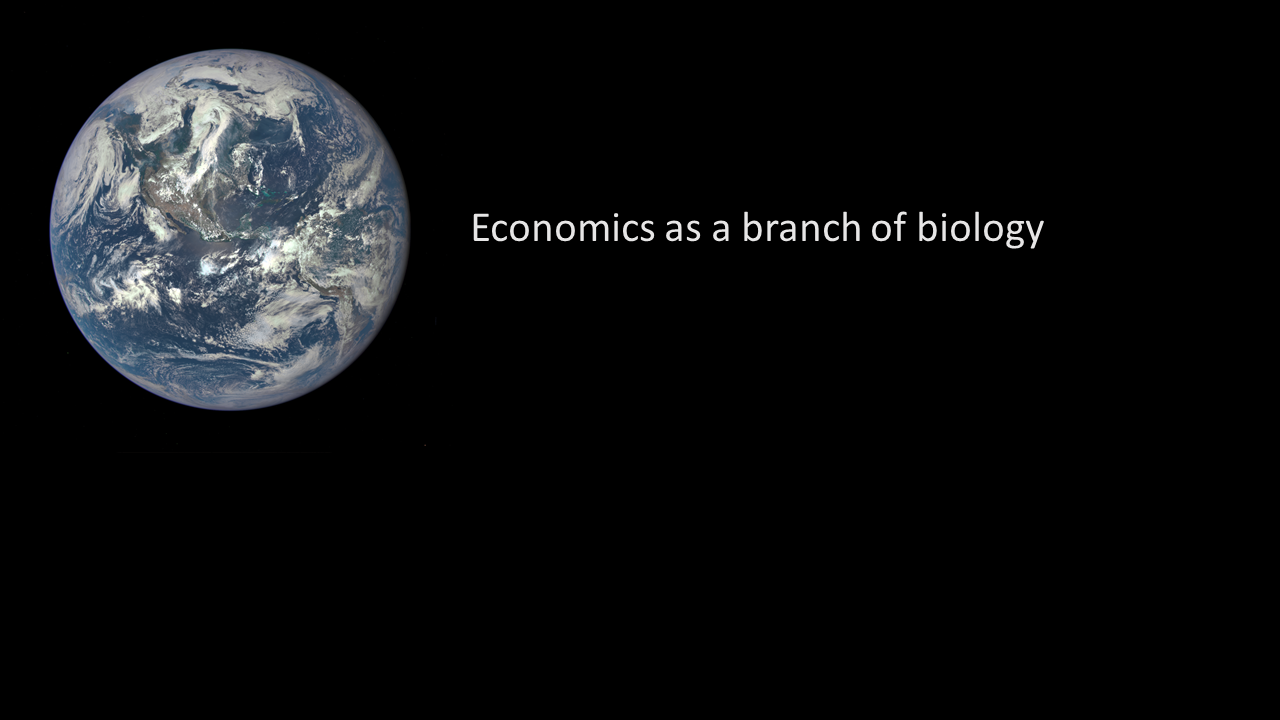
The other thing that Marty said that I think is really right that is controversial among economists is that different fields like to see themselves as the primary science and every other field as derivative from them. Obviously the physicists have a good claim for being the fundamental science but economists like to think of everything as really all economics and everything’s a subset of economics.
Marty Hoffert used to say, “economics is the study of allocation of scarce resources by one species on the third planet orbiting some minor star in some galaxy that’s basically ignorable.” Economics is an important science but it’s a branch of behavioral biology. We need to take their mathematics with a grain of salt.

Sorry for making this a little autobiographical but I then went to Penn State and this is where I got more connected up with astrobiology because I had an opportunity to work with Jim Kasting.
Jim was super great and one of the greatest people I’ve ever had the pleasure to work with because Jim was somebody who would get more excited about my ideas than I would. There’s really nothing better in a collaborator that have somebody tell you your ideas are good because most people are telling you your ideas are boring and not worth working on, whereas Jim would be like “oh, that’s great”. And so we did things like: we did one paper on early Earth being susceptible to CO2 clouds. Was there a metastable state to early Earth? And then we extended Jim Lovelock’s work on the lifespan of the biosphere (and Ariel alluded to this).
Also Jim brought me to a conference at NASA Ames where I got to meet Carl Sagan. This was my one and only meeting with Carl Sagan. I remember at the time (I know this is maybe not a flattering thing) that he seemed to me a lot more like Mr. Rogers than I had anticipated.
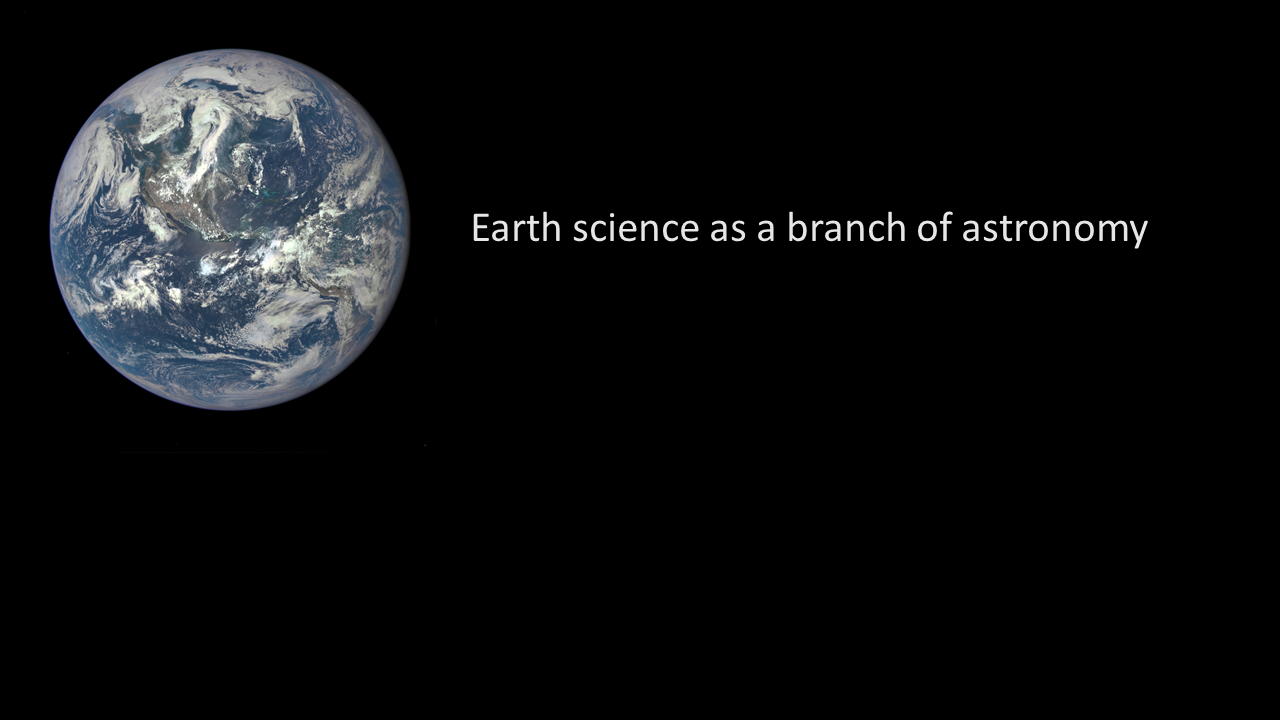
Jim was in a geology department and he said, “look, this Earth is a planet, and earth science is a branch of planetary science which is a branch of astronomy. And so this Geosciences Department is a sort of astronomy department. It is an astronomy department focused on a narrow subset of the universe.” Earth science is a branch of planetary science and it’s about how does this planet function as a planet in some vast universe. That is a very different perspective from those of people who start at very small spatial and temporal scales.
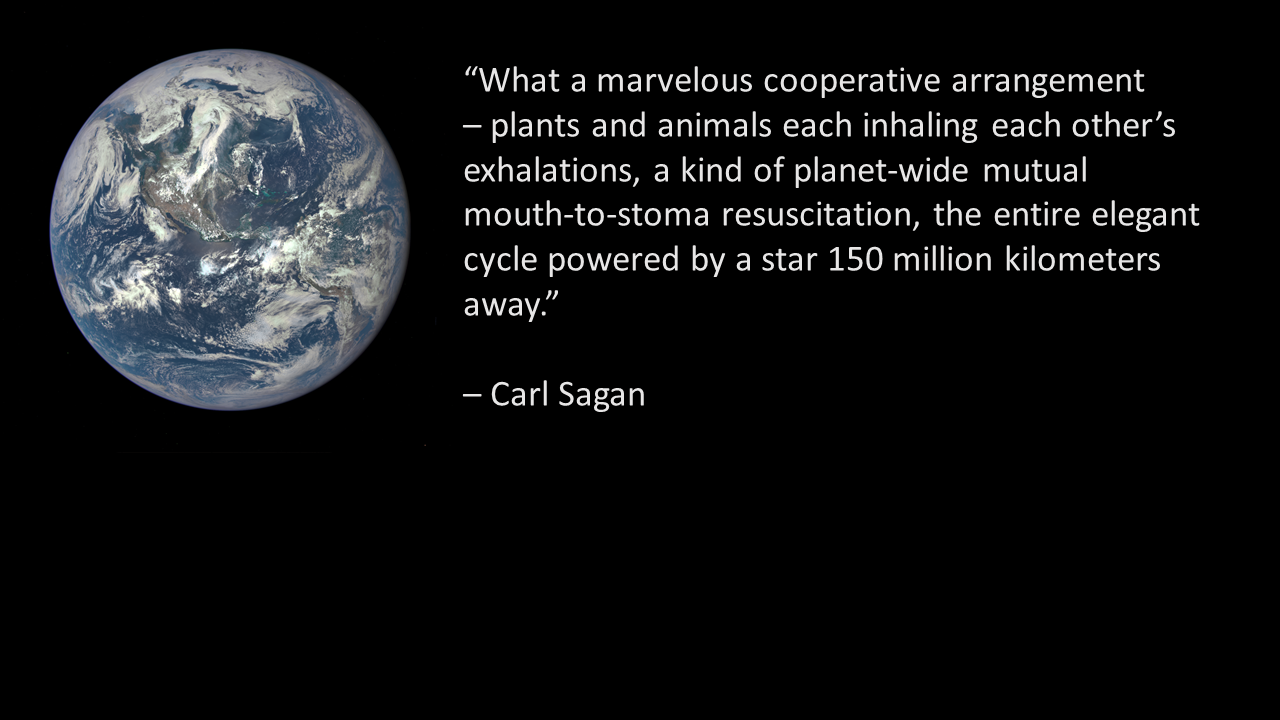
In the 1980s, Jim Lovelock wrote a book about Gaia – about the earth being a homeostatic self-controlling system. And here’s a quote by Carl Sagan that’s in the same direction:
“What a marvelous cooperative arrangement – plants and animals each inhaling each other’s exhalations, a kind of planet-wide mutual mouth-to-stoma resuscitation, the entire elegant cycle powered by a star 150 million kilometers away.” — Carl Sagan
This idea is where I started in graduate school because we were heavily influenced by this Gaia idea. Really, it didn’t make much sense to me because I don’t think plants and animals are cooperating. The plant that gets eaten by an animal was not in a cooperative relationship.
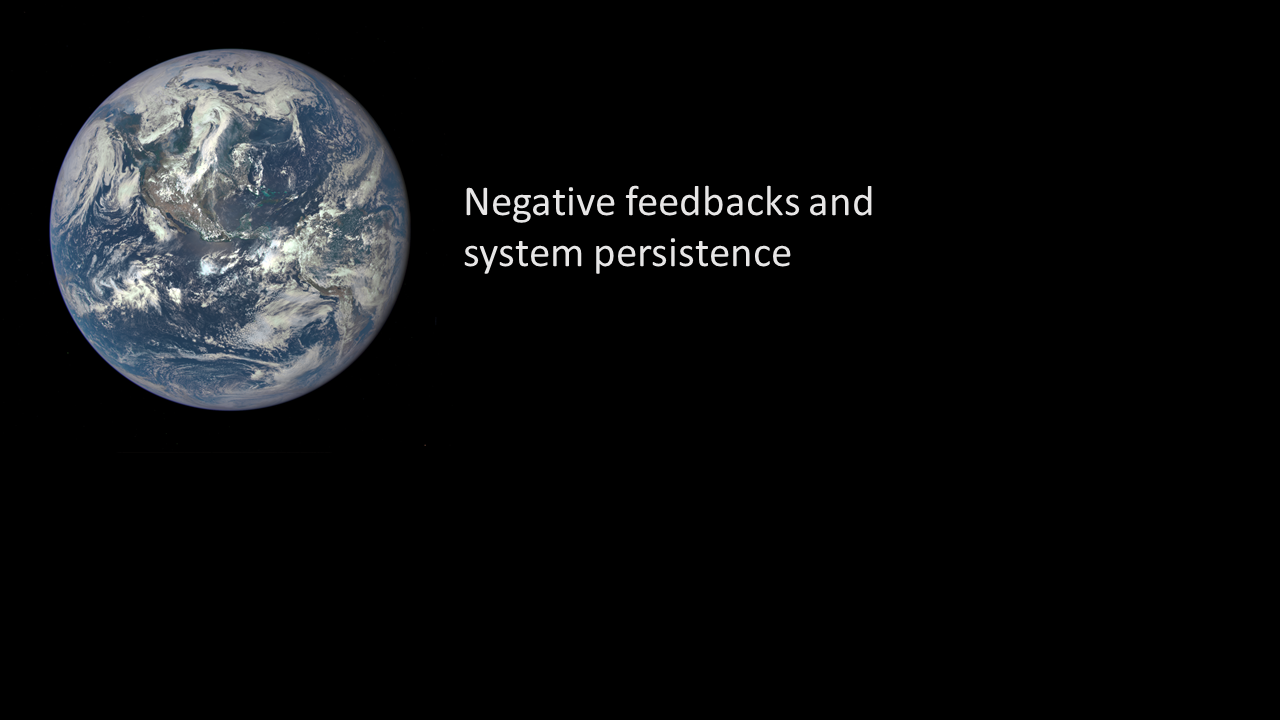
I wrote a paper that was in a Gaia volume from a meeting in San Diego. The way I looked at the Gaia was that if you have a system that’s dominated by positive feedbacks it’s necessarily an unstable system and the system just blows up and converts. So stable systems by their very nature that they’re stable systems are stable because they’re dominated by negative feedbacks.
Let’s just even say you had random different amplifiers and made a million different systems well the you’d find that the population of the persistent ones are the ones that were dominated by negative feedbacks. Just because biology is so big on the planet, some of these systems are going to have biological mechanisms so it just makes sense that that this this planets going to be dominated by negative feedback systems and that that many of those will incorporate biology. It has nothing to do with teleology or goal-directedness.
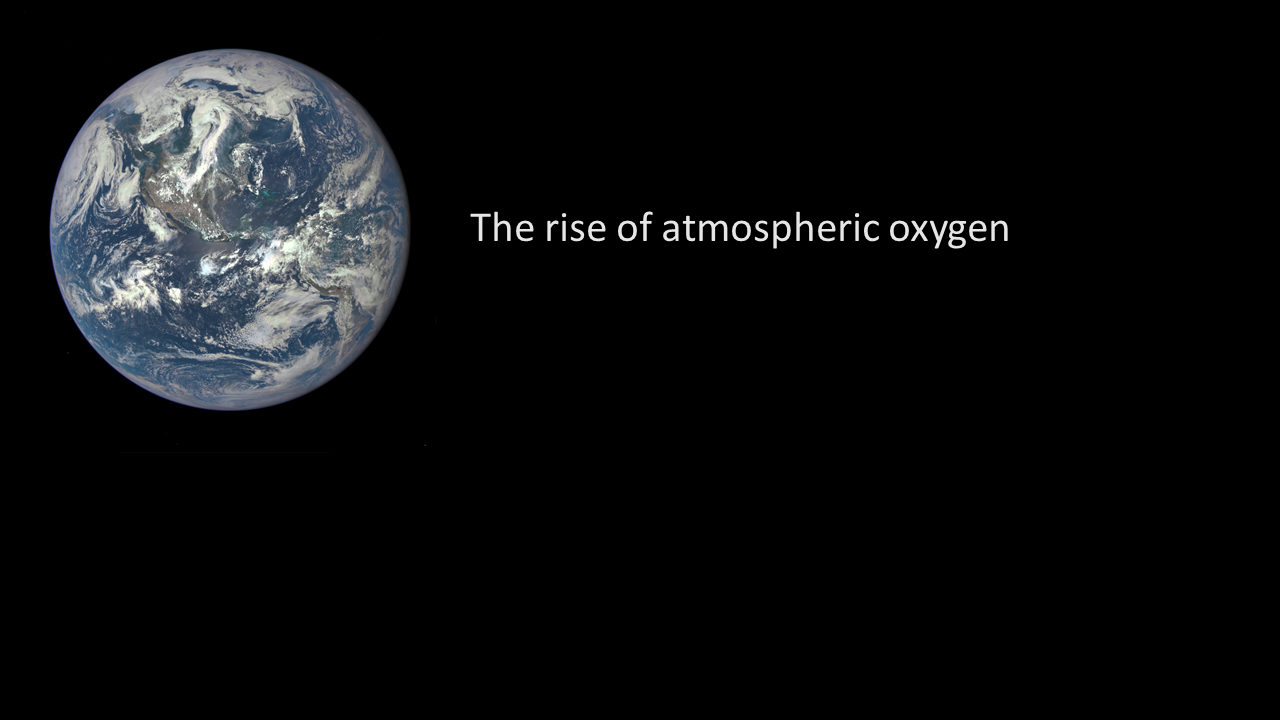
One of the main examples is the rise of atmospheric oxygen a couple of billion years ago. We had anaerobes on this planet they produced oxygen as a waste product and eventually the surface of the earth oxidized and oxygen accumulated (I guess maybe the upper mantle oxidized too) — and the oxygen started accumulating in the atmosphere. And conditions were created that made those organisms not able to live in the environment that had facilitated their evolution.
One of the questions is: Is this going to be our fate also? Is that the way it is for creatures on planets – that if they’re wildly successful they have waste products and eventually those waste products accumulate in the atmosphere or in the environment and then create conditions that don’t allow those organisms to persist anymore? A reasonable first assumption is that this is the way planets with life work – that they produce wastes and eventually produce conditions that are not conducive to their survival.
Of course you can say these anaerobes were highly successful because they’ve created all of us. We are carrying around a bunch of anaerobes in our guts and they’re also in the soils and so on. But is this going to be our fate also – that we’re going to be in some future dome because we’ve destroyed the atmosphere and the waters. Now we create some special environments that we live in.
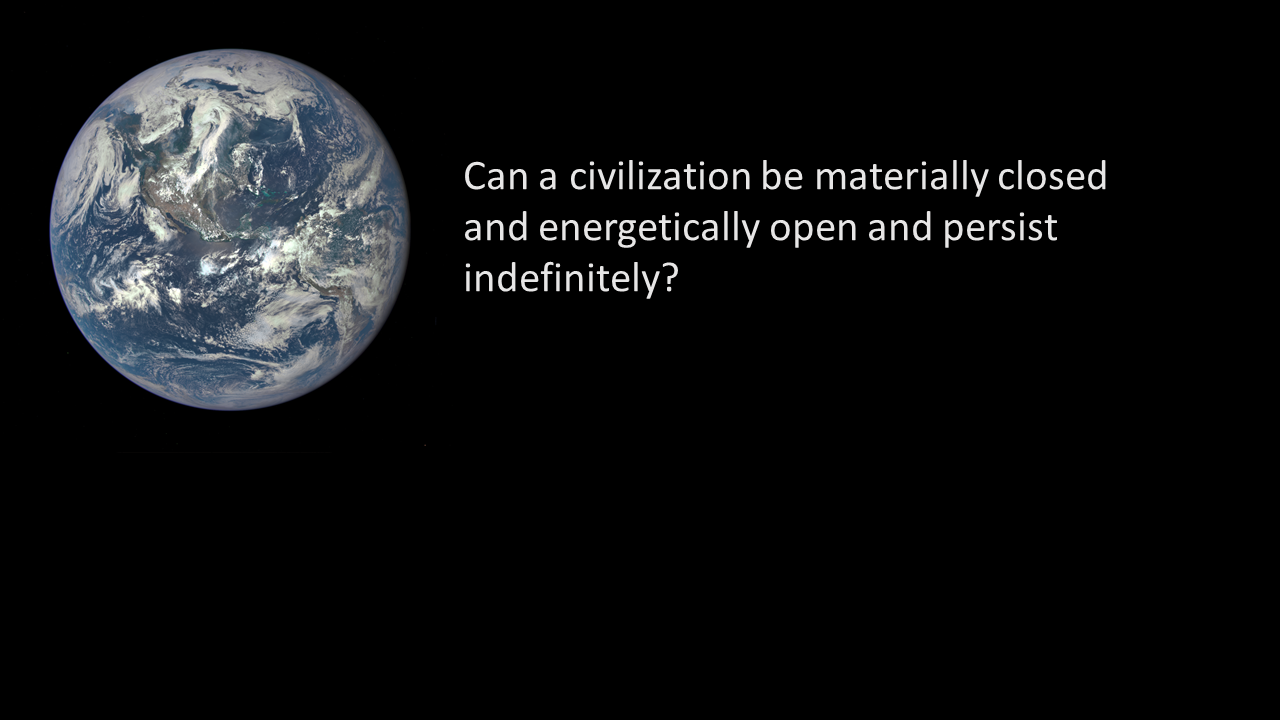
We are back to this question: Can a civilization be materially closed and energetically open and persist indefinitely? I think the answer has to be ‘no’ because there’s no perfect recycling of materials. There will always need to be material input and material output.
But that ‘indefinitely’ is a rather strong word. The question is can we do it on the billion year time scale. And I think the answer is that if we’re smart we could do it on the billion year time scale. It’s not gonna be perfectly closed and we can’t last forever but it can last long enough. And in this universe where looking 10 years ahead is kind of long distance, worrying about billion year time scales is maybe not something yet in the political system. We can’t last indefinitely but we could last on astronomical timescales.
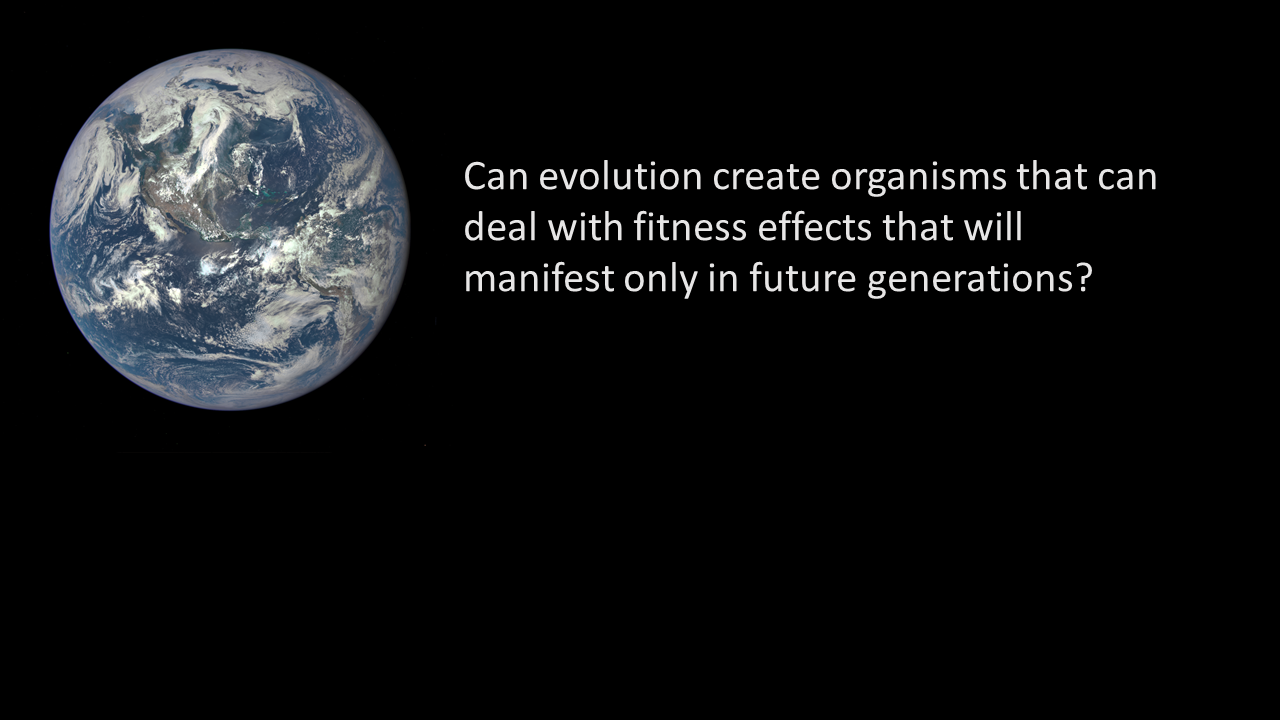
One of the challenges for doing this is: Can evolution create organisms that can deal with fitness effects that will manifest only in future generations?
Evolution works on the organism level: Does that organism get to reproduce and produce a viable offspring? We’re in a situation now where if we are all just local optimizers, that’s not going to work. And so this transition towards long-term sustainability depends on organisms not worrying about their narrow fitness so much as the fitness of the group. And this is where you get back to the evolutionary theory.
I’m gonna do the “consciousness trophic levels argument”.
When the cow wants to eat of grass why doesn’t that blade of grass run away from the cow?
The answer is energetics. There’s just too low an energy density to sunlight and too low conversion efficiency of photosynthesis for plants to have a high energy lifestyle so they need to be have a low energy lifestyle and not be very motile. This is just a conjecture.
Something that I did a before I went to graduate school, I did a neural model of a sea slug aplysia. You could see from the wiring of the nervous system of the sea slug that it basically has sensors on both sides. If it’s sensing more light to the right the neurons go to the muscles on the left side of its body and it moves a little faster on the left and turns towards the light. You can understand its basic behavior patterns just from the wiring diagram of its nervous system.
But if you start getting to higher trophic levels – say a pack of lions or cats or something or dogs who are trying to chase down a highly motile animal — now you have to think “What’s that animal going to do? What am I going to do in response to what it does? How are other people or other organisms in my social group going to respond to that?” And so you start needing to model this system as: I have a mental model of the world. I’m representing myself as an actor in that world. I’m representing other creatures as actors that are making decisions and I’m trying to think of what-ifs and counterfactuals.
It is through this process of representing world as model and self as actor in the model, and other minds as actors in the models, that we get to consciousness.
Bees are the opposite end. Bees are just eating things that are pretty stable. Pollen is not running away from them and so the bees don’t have to have this mental modeling of what other agents are going to do. Bees have evolved in a way that they really do have this sort of group optimization. Obviously genetically there are reasons why, and so the question is: Can we use our brains to have more of this group optimization and not that short-term local-in-space-and-time optimization?
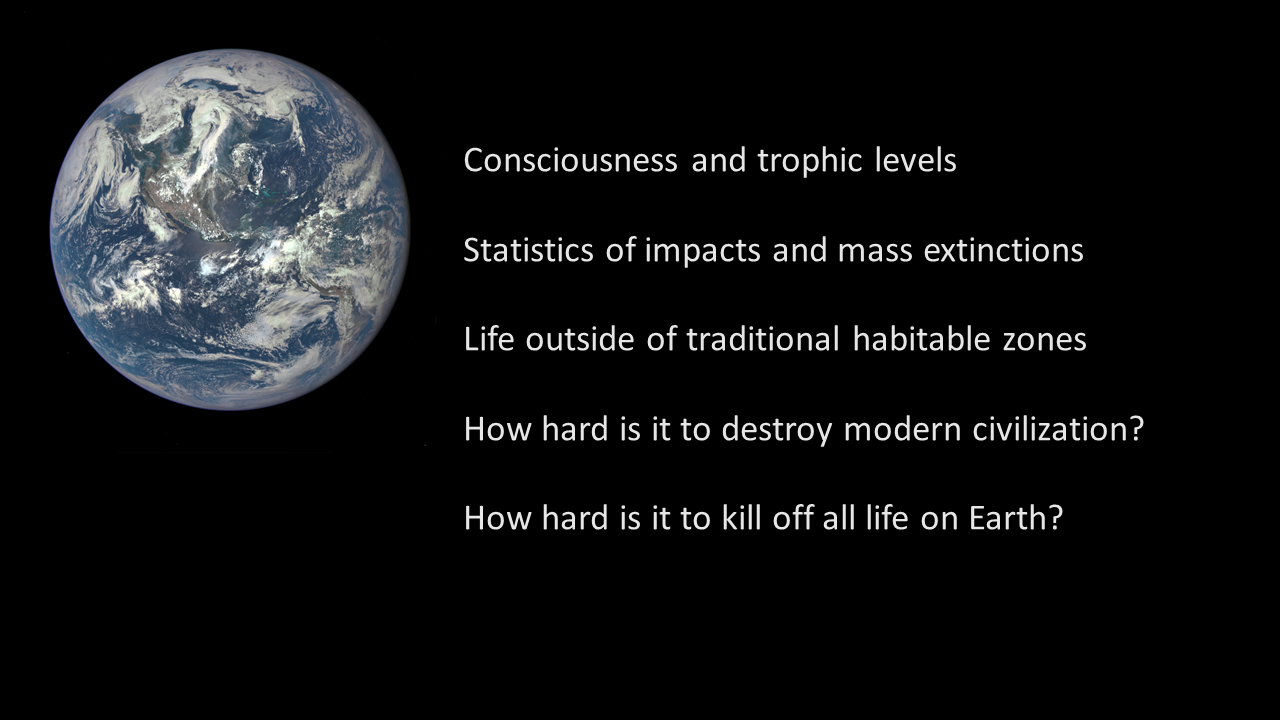
Depending on how the time was going I was going to go into a bunch of little side things but things got too long …
Consciousness and trophic levels — which people want me not to do but I do think that the basic point there is that to evolve consciousness on a planet you have to get to a point where there’s several trophic levels because you need really high energy organisms that are pursuing other high energy organisms, that need to keep mental models of the situation representing self as actor, and that’s where consciousness comes from.
Statistics of impacts and mass extinctions — I’ve been doing a bunch of work with Mike Rampino over the years and I never know what to think about this. Looking at life on Earth (and Mike is convinced and he’s convinced me even though I don’t really like it), if you look at the mass extinctions on Earth and then and also even the secondary ones and then you look at the statistics of impacts and things like flood basalts and that all these things do seem correlated. I was always wondering like how much of this is coming out of cherry-picking datasets. I’m working with Mike on these ones and we have probably done at least a half dozen papers on these correlations over the years. Mike is usually coming up with the numbers I’m doing the statistics and I’m always a little skeptical of the whole thing but it does it’s the same numbers keep popping out of different data sets. It does seem that at least there’s some extraterrestrial pacemaker to some punctuated events in Earth history, and that mass extinction events with extraterrestrial causation, or at least where the extra-terrestrial component is a substantial factor, does seem to be a characteristic of life on this planet and likely on other planets.
One of the things that have come up in this context is that we were doing some work in the Great Barrier Reef looking at the effects of ocean acidification on coral reefs. Elizabeth Kolbert came out and visited us and we ended up as a chapter in her Pulitzer Prize-winning book and which she called “The Sixth Extinction”. One of the questions is: Are we right now facing anything that’s at the scale of the five previous extinctions? Despite liking Elizabeth and liking her book and all, I don’t think what we’re doing now is anywhere near the end like the end Cretaceous extinction event. What we’re seeing we’re seeing a terrible loss of biodiversity but a lot of it is the bigger more charismatic stuff and stuff with economic value or stuff that’s not widespread. I think it’s tragic. I don’t think it’s at the same scale of anywhere close to the end Cretaceous extinction.
Life outside of traditional habitable zones — One of the things that’s really been interesting recently … Back when I was working with Jim Kasting, always the focus was on habitable zones and how did the silicate weather feedbacks affect the habitable zones. People didn’t think about how tidal forces could heat moons of outer planets and these tidal forces could make liquid water deep in the solar system. One of the exciting things that’s happened in this whole field since then is this expansion of the notion of what a habitable zone is and how there’s other energy sources other than the star that can support life. Whether that could support anything more advanced than bacterial life is a question.
I’m just gonna run to the end because I’m good running out of time.
How hard is it to destroy modern civilization? — This shows up in the global change discussion a lot. There’s a lot of people who think that global warming is an existential threat to modern civilization. And other people think we’re going to just muddle through. And it’s going to be a cost on society. It will be an existential for some people who lose their livelihood or lose their lives, but as a civilization it’s a challenge but not an existential threat. I tend to be on that side of things.
It’s a little bit like the extinctions. It’s tragic and unnecessary but not an existential threat. To some people and some communities, yes, but not to humanity.
How hard is it to kill off all life on Earth? — Once we were in some meeting and the question came up of how hard it is to kill off all life on Earth. I think that one’s hard unless you melt the planet because you have the deep biosphere you’ve got life all over the place. If you had a Cretaceous type impact, you could maybe kill off modern civilization but it’s really hard to kill off life on Earth without melting the entire planet.
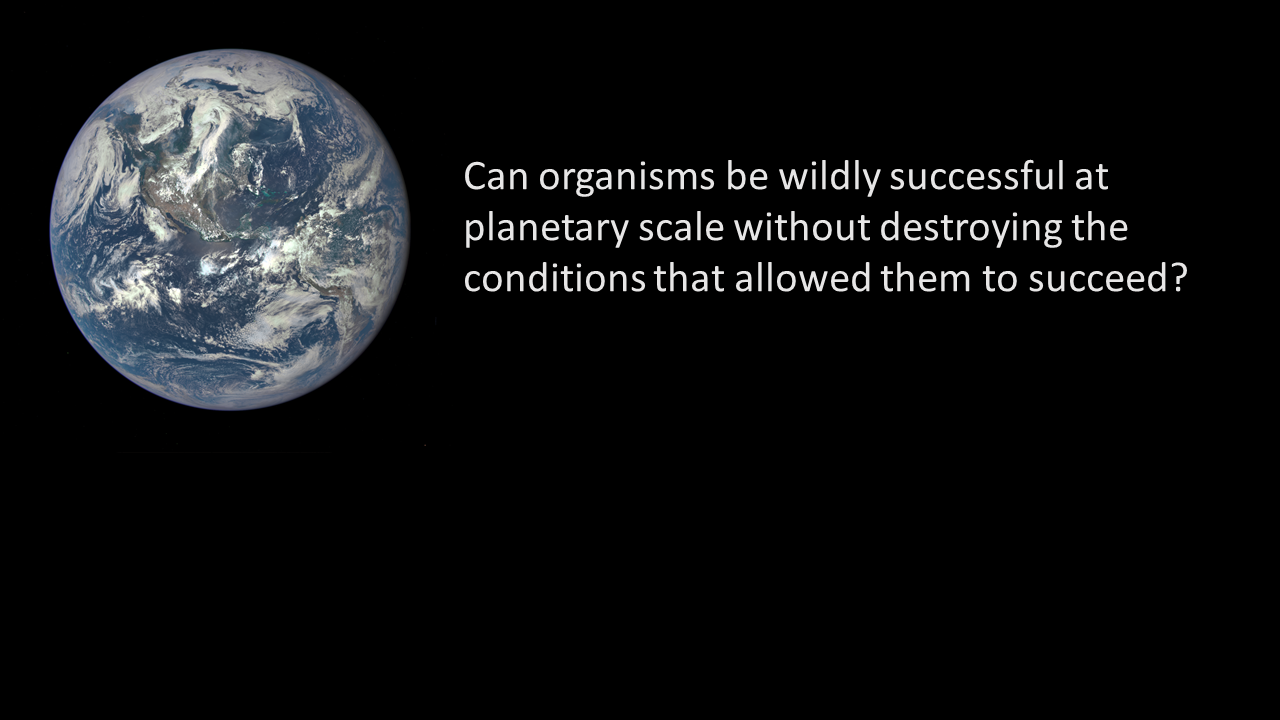
Again, this question here: Can organisms be wildly successful at planetary scale without destroying the conditions that allowed them to succeed?
And the answer is that in most cases organisms would be expected to destroy the conditions that allowed the organisms to succeed but this is not a necessary outcome. And we’re in a special position to affect the answer to this question.
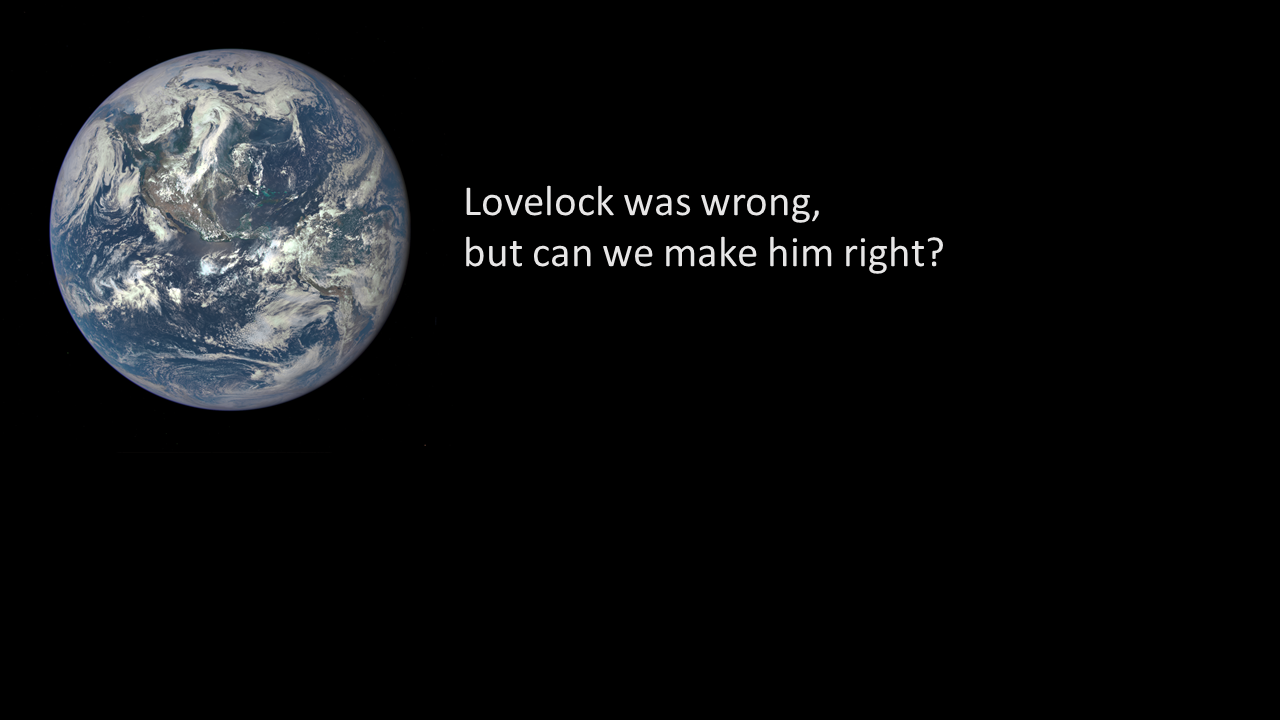
Lovelock was wrong but we can make him right. Lovelock had this idea that there’s all kinds of biological and negative feedbacks in the system and the biology is operating this system in a way that keeps the conditions good for life on this planet. Lovelock was wrong. There is no teleology. There’s no goal directedness to how the planet functions.
Until now.
Because now we have these brains that model ourselves as actors and we think of counterfactuals and consequences of our actions. We have the ability to operate this planet in a goal-directed way.
And being a risk-averse person my goal-directed way of operating this planet is to interfere with natural systems as little as possible. The more we pull back from interfering with natural systems, the more likely we are to persist.
But people can disagree. There are some people who want to terraform Earth and make it nicer. But the main challenge is to make Lovelock right – to operate this planet in a teleological way.
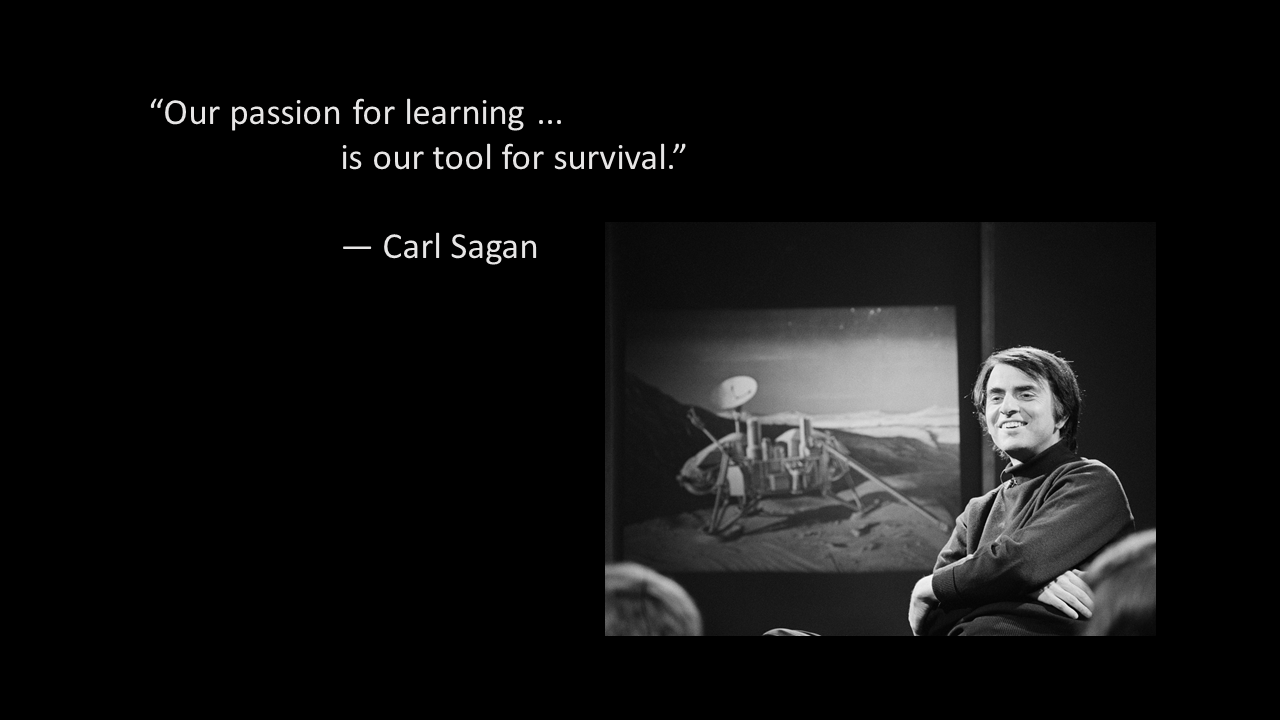
Now coming back to some quotes from Carl Sagan: “Our passion for learning … is our tool for survival.” –Carl Sagan
We learn about this planet, about how it functions. And then we can start operating it a little more cleverly.
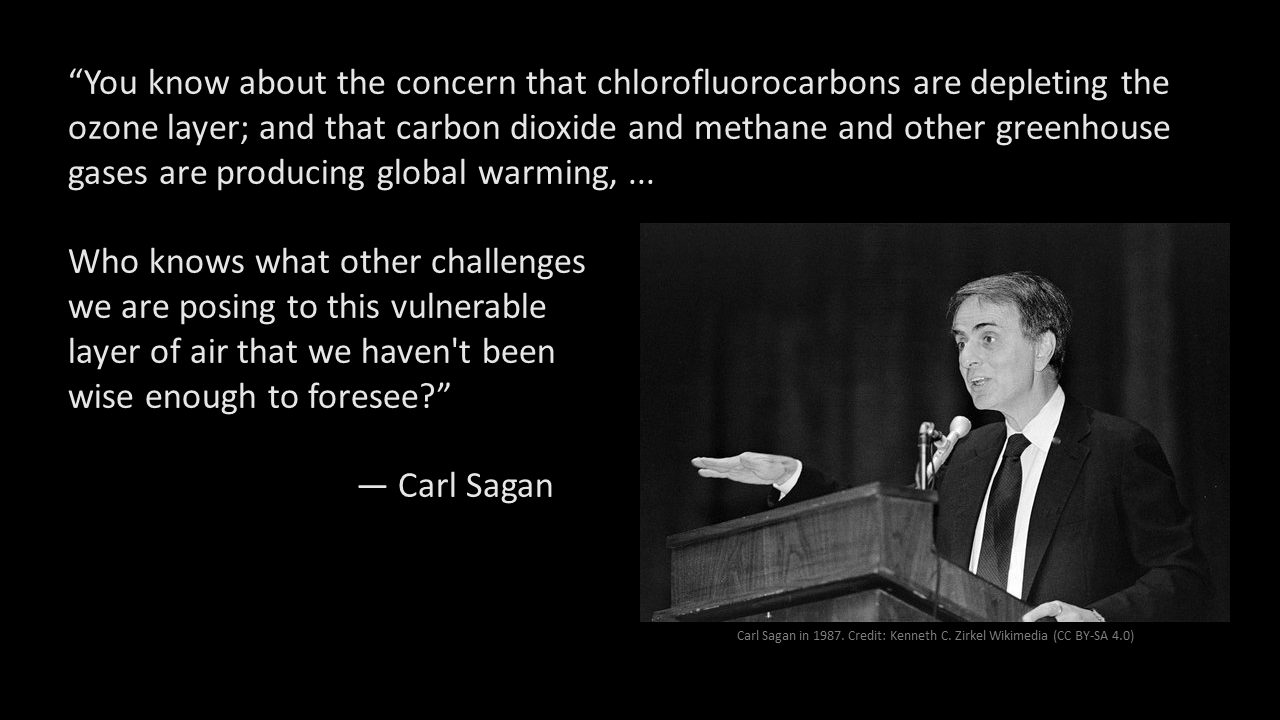
“You know about the concern that chlorofluorocarbons are depleting the ozone layer; and that carbon dioxide and methane and other greenhouse gases are producing global warming, …
Who knows what other challenges we are posing to this vulnerable layer of air that we haven’t been wise enough to foresee?” — Carl Sagan
Our department hopefully is going to hire some new people and one of the things I’ve been arguing is exactly where we should hire is reflected in this quote from Carl Sagan. Over the last century we’ve worried about lead and gasoline. We’ve worried about chlorofluorcarbons destroying the ozone layer, about CO2 and our fuels altering climate, about pesticides so on.
When we solve the climate problem, that is not the last thing. If we solve the climate problem amd we made it so pesticides didn’t kill off all the insects, and got rid of last of the CFCs and so on, something else is going to bite us down the road. Who’s thinking about what comes after the climate problem? What’s the next barrier that civilization is going to run into? We need to be thinking about this now.
Let’s say it was 1918 instead of 2018 and you said okay what science could we be have done in 1918 that would make the world a better place today? I’m doing now energy system forecasting. Energy system forecasting in 1918 would have been a complete waste of time. You wouldn’t have seen wind, solar ,nuclear, or the rise of automobiles, but coming up with new materials, obviously health and education, but coming up with new materials … If you were to come up with silicon chips and carbon nanofibers … All these things in 1918 that would have been great but you also needed to couple that with life cycle analysis so that when we release these new materials into the environment, we understand their long-term effect. These environmental studies is something that if they had done in 1918 could have protected people children from getting lead in their brains. It could have protected us from climate change. And this anticipatory science of what materials can we produce and then what happens when those materials are released into the environment is critical.
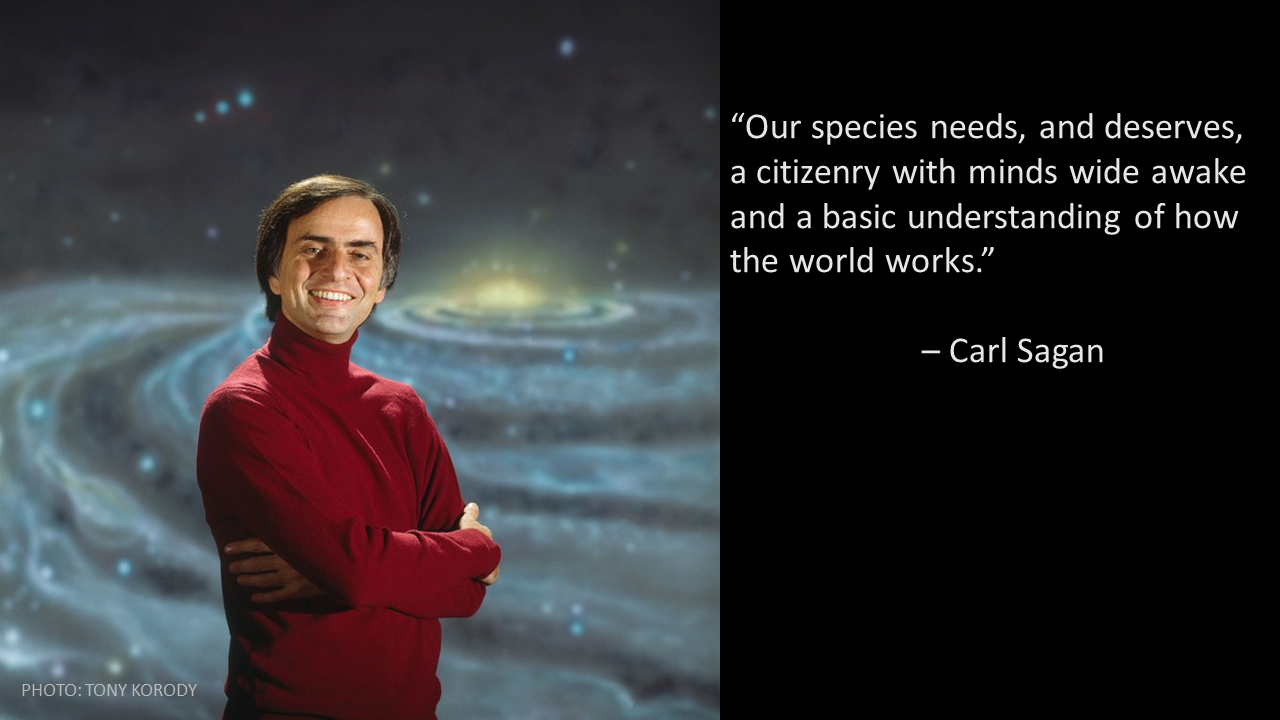
“Our species needs, and deserves, a citizenry with minds wide awake and a basic understanding of how the world works.” — Carl Sagan
Another thing that Carl Sagan pointed out is that democracy depends on an educated population. We obviously don’t have an educated population right now.
I’ve had people email me telling me that I’m a technologist and it’s how bad I am for believing in technology. And I say, “look you’re using a computer to tell me that technology is bad”. People assume a cellphone just works and that’s not technology. Technology is that scary thing.
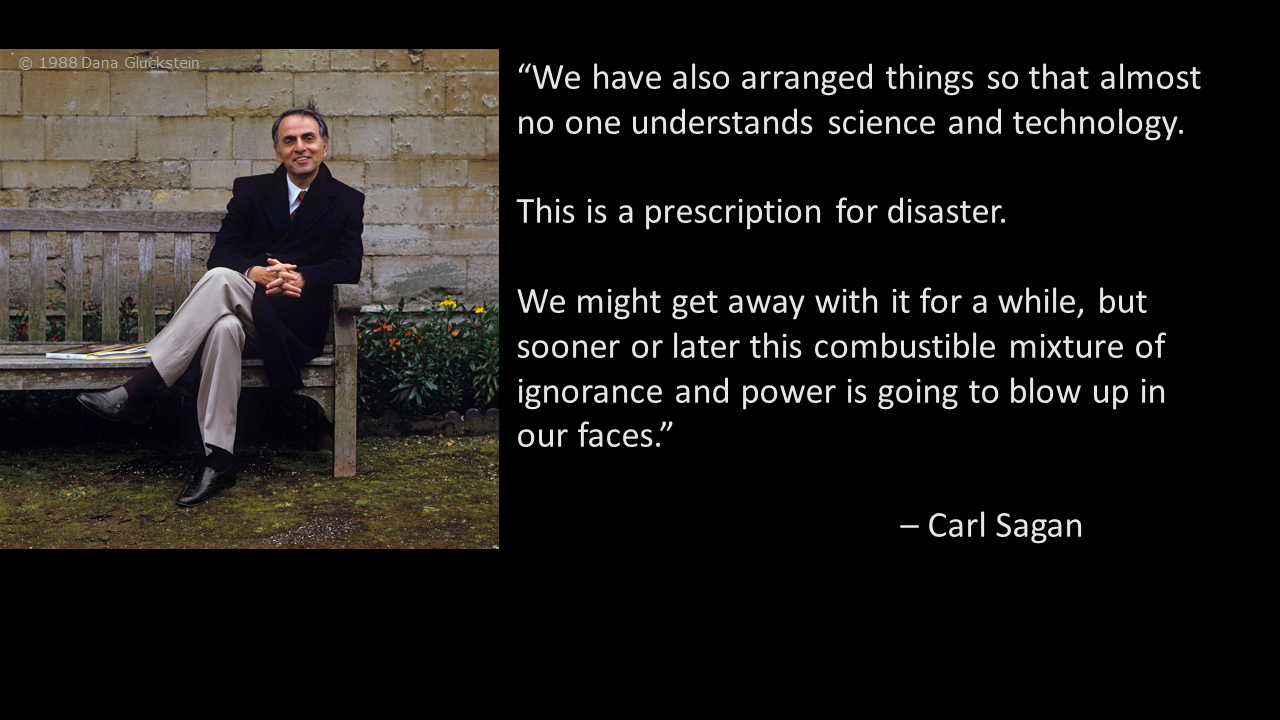
“We have also arranged things so that almost no one understands science and technology.
This is a prescription for disaster.
We might get away with it for a while, but sooner or later this combustible mixture of ignorance and power is going to blow up in our faces.” — Carl Sagan
Unless people understand something about science we’re not going to be able to deal with our problems properly. We need a population that understands how the world works and can vote appropriately. And this is the centerpiece of my talk: Can we live on this planet a long time and can we get past this a tendency of evolution to optimize the fitness going just one generation forward? Can we can we make Lovelock right? Can we operate this planet for the long term?
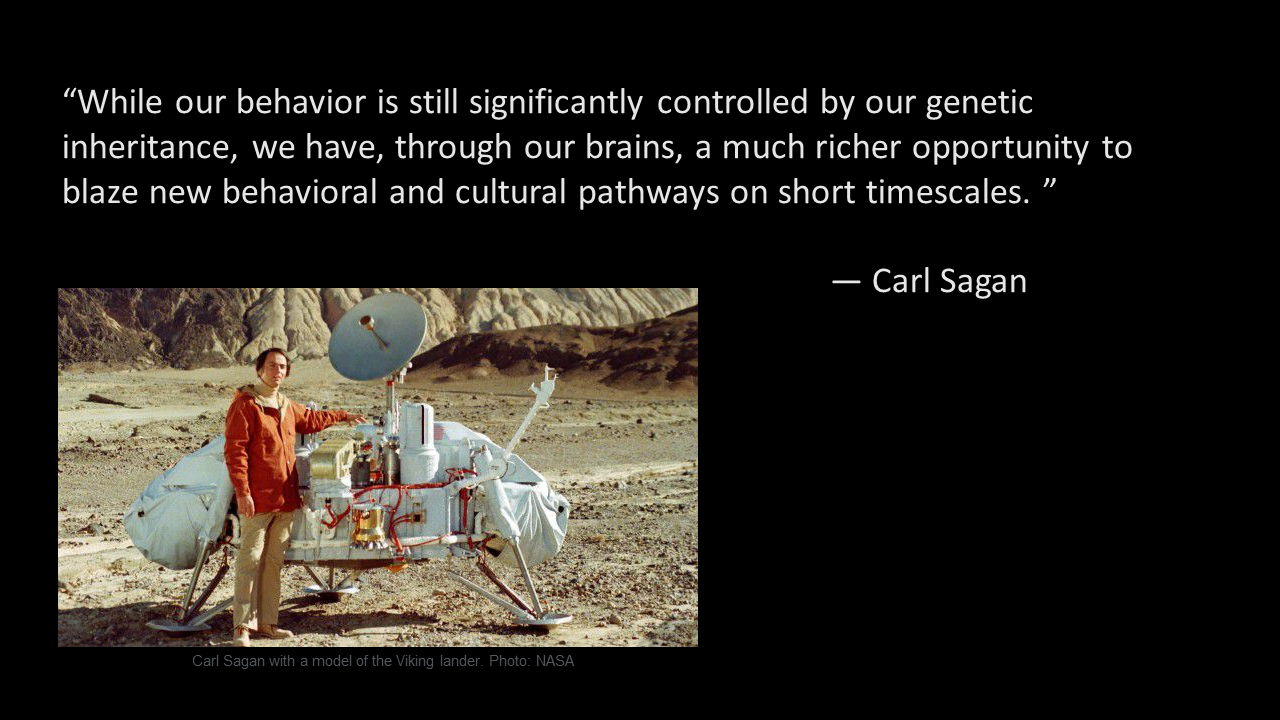
“While our behavior is still significantly controlled by our genetic inheritance, we have, through our brains, a much richer opportunity to blaze new behavioral and cultural pathways on short timescales. ” — Carl Sagan
This is what we really need to be doing with our science and with our lives.
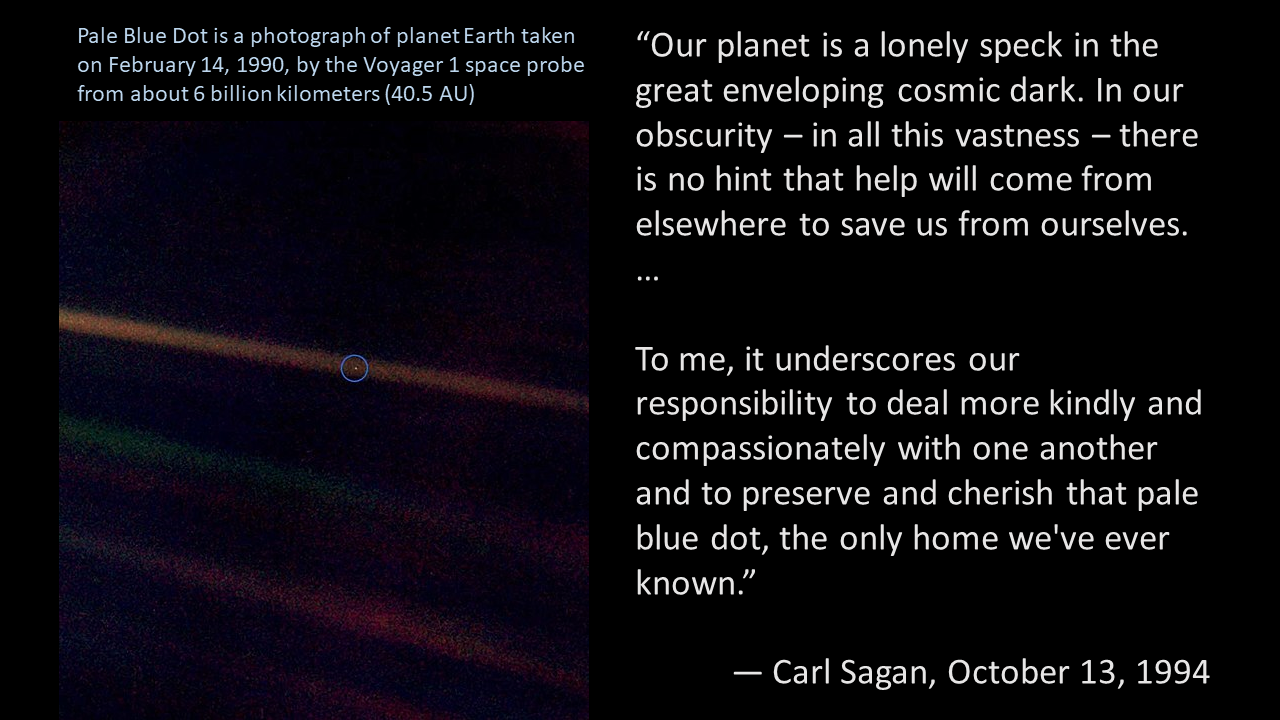
Ariel had this quote and so I’m not going to go through it again but just looking at our planet as one of many planets in the universe and realizing that we are on this Ecosphere – the spaceship Earth – and we need to try to help life as we like it persist.

Just to remind you of this other quote: “Extinction is the rule. Survival is the exception.” — Carl Sagan
We’re an exceptional species but we need to work at it.
Question Period:
Note that questions were not caught by the transcription, so these are lightly edited versions of Ken Caldeira’s answers to questions.
I said two things that were contradictory one is that that we have to learn how to run the planet and the other thing is I think that I my bias is towards interfering in natural systems as little as possible.
I don’t see that as a contradiction in that my feeling is that unless you really understand complex systems well, interference in them is likely to produce unanticipated consequences and is dangerous. If the natural system in which we evolved is providing us a pretty good home then maybe a risk-averse way to run that planet is to let that natural system go on.
I did some work with Edward Teller and he wasn’t worried so much about global warming as he was about going into the next ice age. He asked whether we, for the next Ice Age, we could engineer our way out of that. Obviously this interference is very dangerous.
Let’s say is the Sun heats up and now we’re not worrying about the next decades but say a billion years. We can do things to put particles either at the L1 point between the Earth and the Sun or in orbit around the earth or in the stratosphere and reflect additional sunlight away from the earth and extend the lifespan of the biosphere.
So I think right now our best course is to minimize intervention in the system but that eventually that it might be in people’s interest to take some active role.
But right now keeping the hands off the rudder is the best course of action. And right now unfortunately we we’re intervening in the system without understanding — or with understanding and without caring — and we have to stop doing that.
Back to economics a little bit …
We evolved as local optimizers but we are heavily culturally influenced. Camus, who Sagan was reading, had written about imagining Sisyphus as happy pushing that stone up the hill. And that you wonder about the people who built the Nortre Dame cathedral as a multi-generational project that was aspirational towards some idea of permanence. Are these are sort of serfs working on this thing and just because they need to get money for food or did this gave people meaning to people to lug these stones and build
Nortre Dame. We can get collective me out of out of a project that would be positive for all of humanity and that in a way this sort of economics and even evolutionary theory emphasizing self-interest and narrow personal gain ….
I think a lot of us are motivated by approval of our peers, by wanting a feeling of meaning in our lives and so on. And not everything we do is narrowly self-interested. And maybe if in our culture we tried to emphasize more doing things for the public good that maybe more people would start doing things for the public good.
I don’t know how much time we have but okay.
I think intelligence is pretty easy to evolve that that I read this nice book by Frans de Waal. It was “Are We Smart Enough to Know How Smart Animals Are?” and a main point is that brains have a cost. They require a lot of energy so it’s resources won’t be used for anything else. Frans de Wal said basically that we have the brains that maximize our fitness. If you look at an interesting cases, look at octopus because most other intelligent organisms are vertebrates and we have come from the same line of brain function. Our brain architectures are the same so octopus are interesting to look at because they’re invertebrates. They have a distributed brain so they can tell one of their arms to to explore over there and the actual detailed exploration will be done in the intelligence of that arm. It will be done in the arm rather than in central processing.
But octopus only live a year or two. They’re carnivores. They invade disturbed places and and so they need to go in and have that dexterity to figure out how to adapt to a new situation and, having intelligence, know how to get prey. That’s where they need to think about what ifs — with the prey.
The fact that on this planet right now some forms of intelligence develop both in vertebrates and invertebrates and that’s just at this time now…
Why aren’t octopus more intelligent? Because it wouldn’t improve their fitness to be more intelligent.
It tends to be carnivores and social animals … and so social carnivores are the intelligent animals because they need to coordinate with other beings and they need to go after motile organisms.
Anytime you have high number of trophic levels and social organization you’re likely to get consciousness.
Unfortunately, there is there another session coming in here is somebody like waiting to use the room …
I don’t but I don’t think we have time to go into that so I’m happy to talk to you afterwards but I don’t have concrete ideas on what to do there unfortunately I said to be broadly educated and creative.
But, what?
Oh this Sun — its the stellar evolution, the Sun is getting hotter and eventually we’ll lose our liquid water.
Okay thank you all thank you all
[Applause]
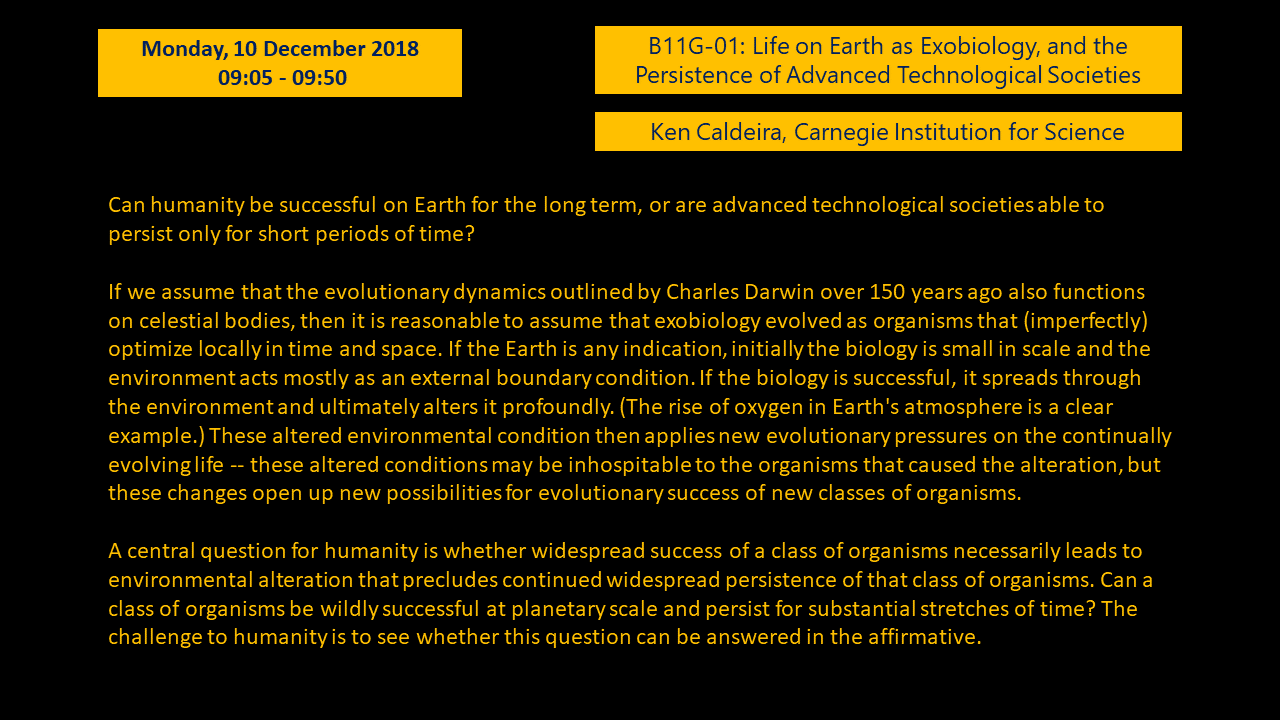


3 thoughts on “Carl Sagan Lecture by Ken Caldeira at the 2018 Fall American Geophysical Union Meeting”
Comments are closed.